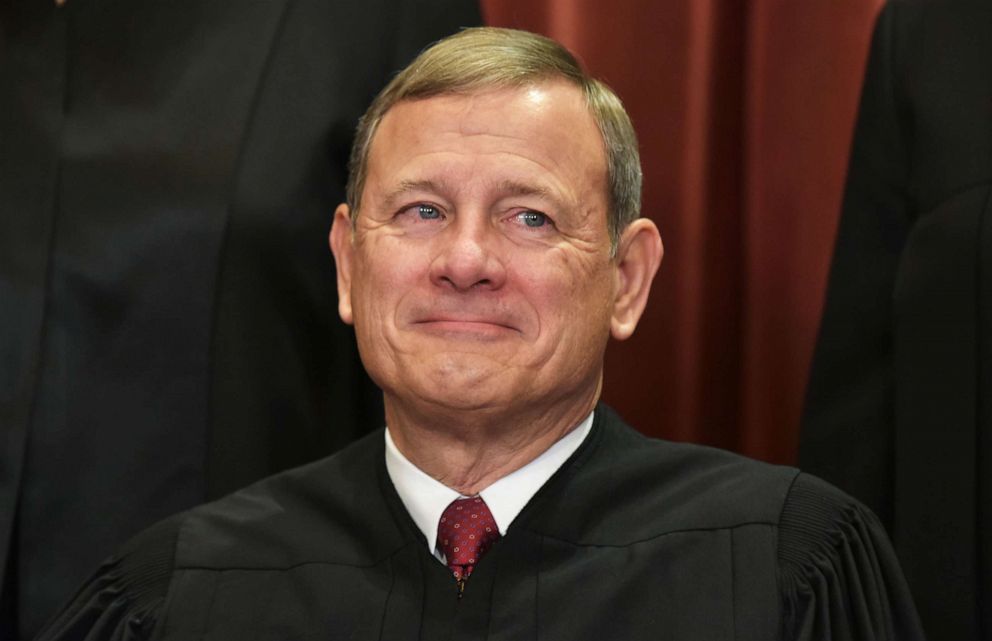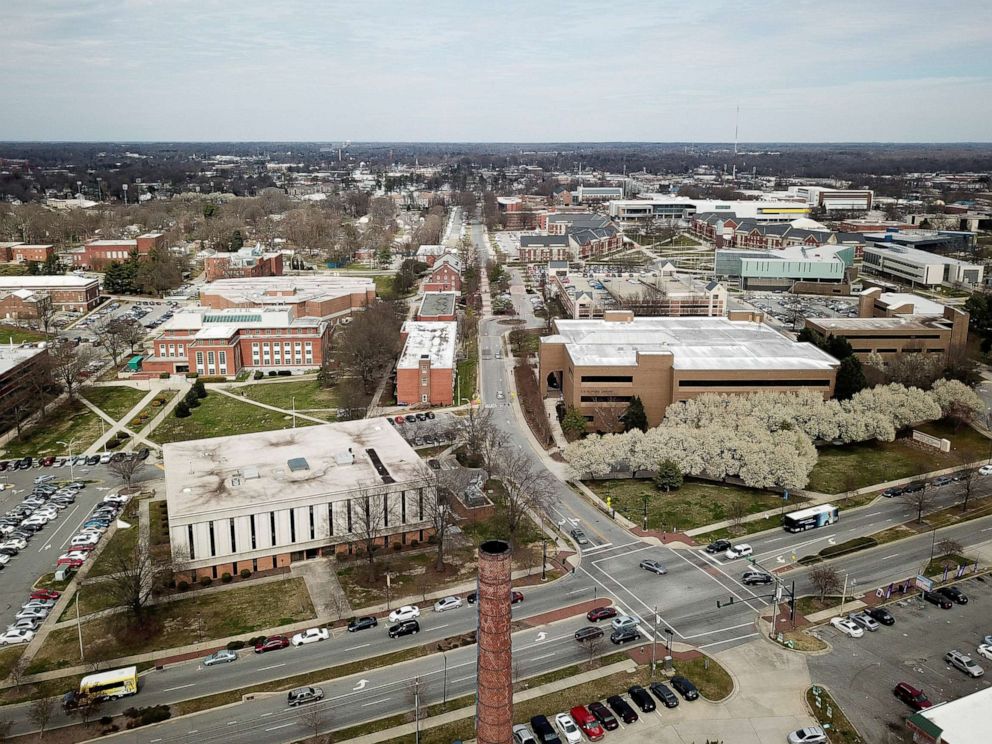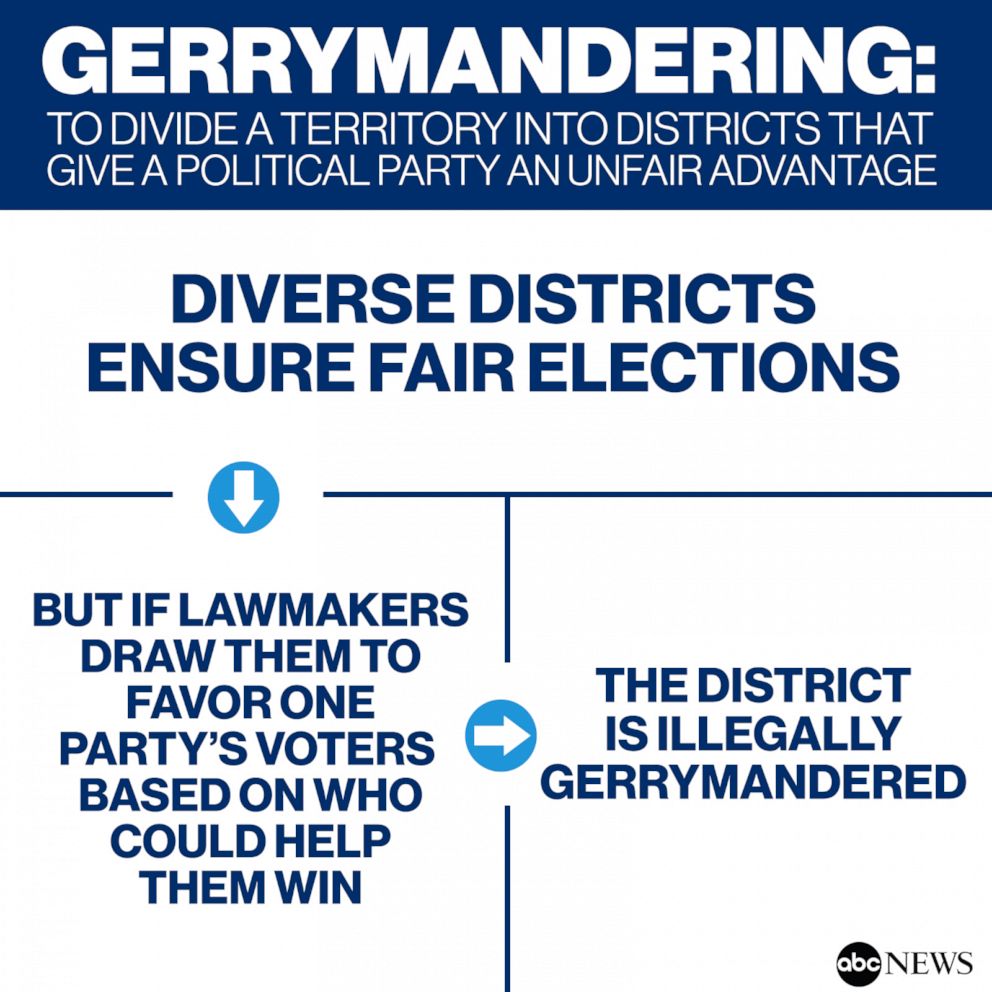Supreme Court divided over limiting gerrymandering
Gerrymandering critics say cases are strongest in a generation at Supreme Court.
The U.S. Supreme Court showed little love for gerrymandering on Tuesday, but the nine justices remained deeply divided about what to do about it and whether to get involved at all.
"In every redistricting, partisanship is going to have a role and always have an effect," said Chief Justice John Roberts, during oral arguments in two major gerrymandering cases that lasted more than two hours. "Is any element of partisanship [in drawing electoral maps] bad?" he asked.
"Why should we wade into this?" Justice Neil Gorusch bluntly asked.
The Supreme Court has generally agreed that "extreme" partisan gerrymandering -- the drawing of electoral maps to advantage one party over another -- is inconsistent with democratic principles, but many justices, past and present, have suggested the issue is better left to the political system to sort out.

Anti-gerrymandering advocates said Tuesday's pair of new cases before the court -- one involving Republican redistricting in North Carolina and the other involving Democratic redistricting in Maryland -- presented the justices with the best opportunity in a generation to set a standard for when the practice violates citizens' First Amendment rights.
"You’re discriminating on the basis of a group’s speech and diluting their votes accordingly," said Justice Sonia Sotomayor, who was the most openly critical of gerrymandering.
Justice Ruth Bader Ginsburg, also a critic of the practice, suggested it was time rules should be imposed.
"Does one person have one vote that counts equally with others if the impact of her vote is reduced based on her party affiliation?" Ginsburg asked supporters of North Carolina's gerrymandered map.
Justice Stephen Breyer worried about what would happen if the court doesn’t act before the next redistricting after the 2020 census.
"If we look at history there really wasn’t much gerrymandering in the past compared to what there could be in the future with computers," he said.
The justices' action -- or inaction -- on imposing potential limits for partisan gerrymandering will impact how future electoral maps are drawn and whether certain political parties will maintain an advantage for years to come.
Neither the justices nor the plaintiffs challenging the maps in North Carolina or Maryland seemed to offer a clear, compelling or comprehensive guideline for how courts should judge when political redistricting is illegal.
The dynamic was familiar to what played out in a similar case last term: the justices were frustrated and divided about what recourse they may have.
Gerrymandering is inherently political, and that's okay, argued Paul Clement, the attorney defending North Carolina's map.
"Lots of voters live in a district … where they are not going to get their preferred candidate elected," Clement told the justices.
No one thinks it’s unfair, he said, that heavily-Democratic Massachusetts can’t elect any Republicans to Congress even though roughly a third of that state’s voters identify as Republicans.
Gorsuch noted the cases of several states taking concerns about gerrymandering directly to voters through citizen-passed referenda and initiatives. He discussed Arizona being one state that gave a citizen commission -- not state politicians -- the duty to draw legislative districts.
The panel also grappled with whether the Constitution may require proportional representation in Congress and that any redistricting must abide by that standard.
"Doesn’t equal protection suggest political groups need to be treated equally?" asked Justice Brett Kavanaugh.
North Carolina college students claim personal stake in gerrymandering
As the Supreme Court wrestled with the issue , a group of North Carolina college students challenging the partisan practice in a lawsuit said its impacts are unambiguously personal and unconstitutional.
"It's clear how gerrymandering, by itself, dilutes the people power at A&T," said Love Caesar, a 20-year-old junior majoring in history and political science at North Carolina A&T University, the nation's largest historically black university.
When North Carolina redrew its congressional map in 2016, Republicans bisected the university's Greensboro, North Carolina campus in half, looping one part of the school into the state's 6th Congressional District and the other into the 13th Congressional District. College campuses tend to be enclaves of Democratic-leaning voters, but both districts connected to the university are represented by Republicans.
"It's hard to keep up with who's representing us and also -- for myself -- it's harder to increase engagement [in the political process] because of that confusion people face," Caesar, a Democrat, said. "Ultimately, it comes down to students not thinking their vote counts, and unfortunately it doesn't."

North Carolina's voting population is a near-even split between Republicans and Democrats, but Republicans control 10 of the state's 13 congressional seats. In most states, the legislature draws the districts that are used for electing representatives to both Congress and state legislatures and the party in control often uses that opportunity to increase its partisan advantage.
"Does the Constitution impose justiciable limits on partisan gerrymanders? These cases are the best opportunity in a generation or more to resolve that question," said former U.S. Solicitor General Seth Waxman, who served during the Clinton administration.
Last term, the justices declined to consider the question, punting the case back to lower courts because they said critics of gerrymandering failed to show a "personal stake" in redistricting or any real harm to potential constitutional rights. Roberts, at the time, also voiced skepticism about having courts intervene in the political process over complaints that he said amounted to "sociological gobbledygook."
In this pair of new cases before the Supreme Court -- one involving Republican redistricting in North Carolina and the other involving Democratic redistricting in Maryland -- the plaintiffs say they answer the justices' concerns and propose guidelines for determining when gerrymandering goes too far.
"This case sets the stage for a neutrally applied standard for those cases of [gerrymandering] in the extreme," said Celina Stewart, advocacy director for the League of Women Voters, a plaintiff in the North Carolina case.
Republicans who brought the Maryland case say a Democratic-led redrawing of one long-reliably GOP congressional district -- turning it in favor of Democrats -- violated their First Amendment right to association by diluting their votes and depressing participation in the political process.
"The gerrymander was a resounding success. Republican votes were diluted so substantially that a Democrat has won every election since 2011 -- including in 2014, a wave year for Republicans," the affected voters write in court documents.
"Interest in Republican congressional politics in the district has also declined significantly. As supporters of the Republican Party in the area have become disengaged and disinterested, fewer voters have turned out for the primaries, and party fundraising has fallen off," they said.
Critics slam 'packing' and 'cracking'
Victims of extreme gerrymandering by both political parties "suffer from packing and cracking," said Kathy Feng, a founder of the California Citizens Redistricting Commission and anti-gerrymandering advocate for the group Common Cause.

Lawmakers who draft district boundaries for electoral advantage typically try to "pack" like-minded voters into concentrated districts and "crack" other pockets of like-minded voters into separate districts to minimize influence in the voting pool.
"Over the course of that period of time, things just keep getting worse and worse, and the information about how sophisticated the parties have gotten becomes clearer and clearer," said Daniel Tokaji, a leading election law expert. "We've now got this evidence of impact on the parties outside the electoral process."
Gerrymandering has been part of the American political process since its founding, but didn't begin to face legal challenges until 40 years ago. North Carolina, Maryland and other states whose electoral maps have been challenged in court have said politics are inseparable from gerrymandering and impossible to regulate.
"You can't answer the unanswerable question of when politicians acted too politically," said Misha Tseytlin, a constitutional lawyer and former clerk for Supreme Court Justice Anthony Kennedy, who has defended gerrymandering before the court.
North Carolina argues that there is no constitutional rule against gerrymandering and weak evidence that individual voters are harmed by it.
"Their grievance is a fundamentally political one that the framers delegated to the political branches," the state says in court briefs.
Maryland says it opposes "abusive partisan gerrymanders" but that it's not easy for a court to impose a fair, consistent "manageable standard."
The Supreme Court has generally agreed that "extreme" partisan gerrymandering is inconsistent with democratic principles, but struggled with how to handle it. Many justices, past and present, have suggested the issue is better left to the political system to sort out.
But advocates for new rules on gerrymandering are hopeful this case could be different. Lower courts in both the North Carolina and Maryland case sided with the voters who brought the challenges.
One federal district court proposed a three-part, district-by-district test for the judicial system to use in evaluating gerrymandering: Were the lines drawn explicitly to "crack" and "pack" voters? Did the result "dilute" the vote of some voters? And was there a "legitimate justification" for the dilution?
The Supreme Court could choose to embrace that standard or set a different one for political gerrymandering. Alternatively, they could say challenges to political maps can't be litigated in the courts at all and must be left to the political system.
High stakes in court's decision, expected in June
The consequence of the Supreme Court's decision will be significant as state legislatures across the country are poised to redraw their state legislative and congressional districts at the conclusion of the 2020 census.
Clement offered a stern warning to the court: "If you get into the business of adjudicating these cases, they will come in large numbers," he said. "You won’t be able to get out of the political thicket."
Allison Riggs, attorney for the League of Women Voters of North Carolina, a group challenging the state's gerrymandered map, said the court also risks its reputation by doing nothing. "This is not self-correcting," she said.
The court is expected to issue a decision in the two cases by the end of June.



